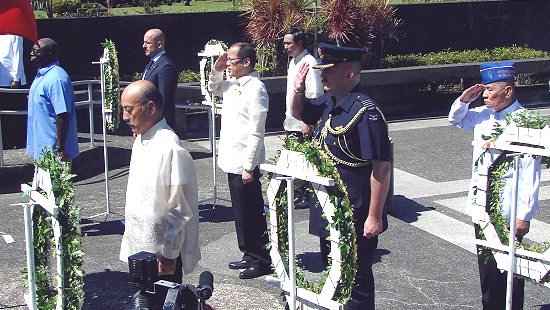Remembering Leyte Gulf
Landings
|

President
Benigno S. Aquino III (center 2nd row) leads dignitaries
(clockwise) H.E. Toshinao Urabe of Japan, US Ambassador Harry
Thomas, James Cristoff of Canada, Leyte governor Carlos Jericho
Petilla, Veterans Federation of the Philippines executive
vice-president Francisco San Miguel and Capt. Craig White of
Australia during the wreath laying ceremony in connection with
the 67th Leyte Gulf Landings anniversary at Candahug, Palo,
Leyte, October 20. (VINO R. CUAYZON) |
By ALICE NICART, PIA
Samar
October 20, 2011
PALO, Leyte – As a
young adult, he was merely a fisherman, a vocation he opted to choose
in order to elude the unkind treatment of the Japanese who ruled in
their community, in Tanauan, Leyte.
Yet, there were times
when he could not escape the cruelty of the invaders. Sometimes, when
he would get ashore, the Japanese would ask, “Sakana nay?” (Is their
fish?) and when he would answer “Nay” (none) he would be slapped in
the face.
Thus recounted Mr.
Leovigildo Azucena, 88, in a brief interview shortly before the formal
commemorative program today for the 67th Leyte Gulf Landings or the
famously known MacArthur Landing.
The fondly called Lolo
Gil narrated, that he was fishing one night in October when he heard
of sounds, which he dismissed instantly, could not be the sounds of
bombs.
Not long after,
however, what he rejected as sounds of, became an ultimate and a sheer
reality, as more and more ships appeared his very eyes, which were
firing to the direction upshore.
“Move out!, move out!”
a crew shouted at him repeatedly.
“No, sir! Please! I am
a Filipino”, he cried and he gave them his boiled banana for dinner.
In an instant, he was
picked up from his tiny boat and found himself in the middle of
American soldiers. Still frightened for any harm the armed men could
do to him, he chilled in fear.
But a small table was
arranged in his front and his fear turned to joy for he imagined an
American food is about to be served him. But no. The Americans laid
wide a map on the table, pointing at some angles and questioned him,
“Where are you?”, “Where are we?”, “Where is Tolosa?”, “Where is the
mountain where the Japanese hide?”
Because he believed in
the intentions of his new found friends, and fed-up by the cruelty of
the Japanese, the young gentleman faithfully answered the questions.
This writer asked why
he spoke good English then, “I was a Grade VII pupil when the war
broke, and there were even times when I would be the substitute of our
teacher”, he replied.
As he continued his
recollection, he said that after the friendly interrogation, he was
allowed to eat with a Chorizo which according to him was as big as his
legs with matching pack of Lucky Strike cigarette.
At dawn he was told to
disembark the ship and go to the civilians as far as 20 miles and
informed them of another bombing that was to happen any day soon.
And the bombing did
occur, but he stressed there was no Filipino civilian found dead.
Sooner, Gil was hired as an interpreter by the American soldiers and a
member of the ship’s crew until he was registered as a US Scout. Yes,
he maintains his claim, that he was the only Filipino who was able to
board the American ship during the Leyte Landings.
Now at 88, and
already a Lolo, the young Gil, (some 67 years ago), assured he is
still vibrant specially, he said, when he sees ladies in mini skirts.
He has since enjoyed his benefits as a US Veteran and all his six sons
who entered the US Navy are now living in the States, the others have
already retired. He promised though he is no longer returning to the
US because it is in the Philippines where the real paradise is.